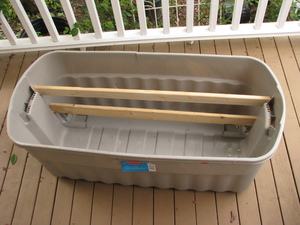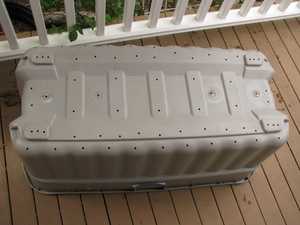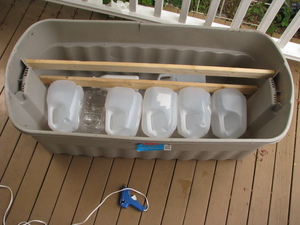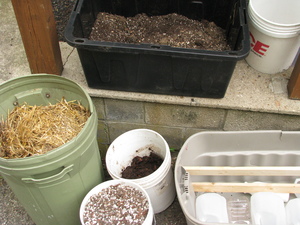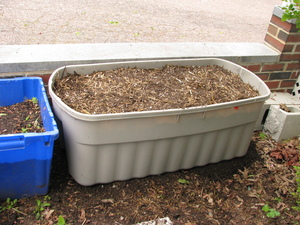Planting dreams
Apr. 16th, 2023 11:45 amI finally bought some more potting soil, set up a seed-starting tray, and put some seeds into the dirt.
I'll be taking a landrace approach starting this year: No more individual packets marked with variety, harvest date and location, and careful notes. No, they're all just going to get mixed together, with new seeds mixed with old ones. I'll overplant, both to use up old seed and to force myself to thin the seedlings for just the healthiest ones that can best tolerate my particular brand of neglect and weird soil nutrient levels. I'll probably also transplant too many so that I can thin out in a later step as well.
----
Tomatoes: I have seeds collected from a mix of cherry tomato varieties we picked at Waltham Fields. No big tomatoes this year, as the squirrels and/or rats are prone to taking a single bite out of the big tomatoes.
Tomatillos: I've recombined all my bags of tomatillo seeds. There might be some golden berry or ground cherry seeds in there too, so I'll *definitely* have to overplant these. :-P Anything fuzzy is a golden berry, and will be weeded out, as they are a long-season plant. (The one I brought indoors in autumn did finish fruiting, but very reluctantly. Not worth it.) Ground cherries are welcome!
Hot peppers: A mix of seeds I collected at Waltham Fields this past summer. I made a fermented hot sauce and sampled the peppers as I chopped them; if they were nice I put a few seeds in a bowl. The bowl sat out all winter and is very dusty, but it's probably fine. (See notes on neglect.) I've also planted a few seeds of a sweet Italian pepper (probably Jimmy Nardello) that has grown on elusiveat's windowsill and even produced fruit during the winter -- very tough, and I want those genetics in there. Maybe in the future I'll try mixing in Capsicum flexuosum to try to get a winter-hardy hot pepper (can I get a long growing season?) I'll transplant a few sweet peppers out next to the hot peppers.
Sunflower: Hopi Dye (deep purple seeds, for dye) and/or Inca Jewels (red rings on some of the flowers). I have one packet of seeds from a really big plant, and another from a plant with gorgeous red/orange on it, and another of mixed seeds from various years. I'm *not* mixing these together; I want to very intentionally keep crossing the first two into the last, and keep selecting for large and colorful. The mixed seeds, interestingly, have pale stripes on them! I don't think any of the parent plants had that. Maybe something else got mixed in, or perhaps this is a heterozygous trait. Anyway, I'll be scraping a lot of the mixed seeds into a promising area along the bike path where they can fend for themselves. Anything good that the birds don't eat too quickly will go back into the mix, and I might do some pollen transfer as well.
Sweet basil (Genovese basil): Probably not a lot of variation here. Some will go into smaller pots that can be brought indoors for the winter, as it turns out that basil can overwinter indoors if you *really* stay on top of getting rid of any flower spikes. (They don't seem to be very susceptible to spider mites.) When it does go to seed it is very prolific, so I've ended up with a *ton* of seed. I should give some seed away. (I often end up giving away plants each year as well.)
Beets: I have some Detroit Dark Red seed from forever ago. No idea if it's still viable, and I don't eat many beets, but beet greens (chard) are nice. We'll see.
Onion: Sometimes we buy onions and they sprout heavily before we can eat them, so I just plant them; later, we get scallions. Sometimes they set seed. I have no idea what variety these seeds are, but I like scallions, so in they go.
Nasturtium (Tropaeolum): Pretty flowers, nice to snack on. We have some railing-mounted planters I haven't used yet. There's a place we get sun but don't have space for regular planters, and it seems like nasturtiums are a good fit. If I get enough seedset, I can make pickled nasturtium seeds, which are apparently like capers.
----
I might also plant out some of the tomatillo, pepper, and tomato directly into the ground just to get a bigger gene pool and more crosses, even if I don't eat the fruits. (I don't know the lead levels here yet, and some would be in my neighbor's yard.) Actually, my neighbor has a raised bed and is somewhat new to gardening; she might agree to grow out some of the peppers and tomatoes for me and return some seeds of any that she likes. :-)
I'll be taking a landrace approach starting this year: No more individual packets marked with variety, harvest date and location, and careful notes. No, they're all just going to get mixed together, with new seeds mixed with old ones. I'll overplant, both to use up old seed and to force myself to thin the seedlings for just the healthiest ones that can best tolerate my particular brand of neglect and weird soil nutrient levels. I'll probably also transplant too many so that I can thin out in a later step as well.
----
Tomatoes: I have seeds collected from a mix of cherry tomato varieties we picked at Waltham Fields. No big tomatoes this year, as the squirrels and/or rats are prone to taking a single bite out of the big tomatoes.
Tomatillos: I've recombined all my bags of tomatillo seeds. There might be some golden berry or ground cherry seeds in there too, so I'll *definitely* have to overplant these. :-P Anything fuzzy is a golden berry, and will be weeded out, as they are a long-season plant. (The one I brought indoors in autumn did finish fruiting, but very reluctantly. Not worth it.) Ground cherries are welcome!
Hot peppers: A mix of seeds I collected at Waltham Fields this past summer. I made a fermented hot sauce and sampled the peppers as I chopped them; if they were nice I put a few seeds in a bowl. The bowl sat out all winter and is very dusty, but it's probably fine. (See notes on neglect.) I've also planted a few seeds of a sweet Italian pepper (probably Jimmy Nardello) that has grown on elusiveat's windowsill and even produced fruit during the winter -- very tough, and I want those genetics in there. Maybe in the future I'll try mixing in Capsicum flexuosum to try to get a winter-hardy hot pepper (can I get a long growing season?) I'll transplant a few sweet peppers out next to the hot peppers.
Sunflower: Hopi Dye (deep purple seeds, for dye) and/or Inca Jewels (red rings on some of the flowers). I have one packet of seeds from a really big plant, and another from a plant with gorgeous red/orange on it, and another of mixed seeds from various years. I'm *not* mixing these together; I want to very intentionally keep crossing the first two into the last, and keep selecting for large and colorful. The mixed seeds, interestingly, have pale stripes on them! I don't think any of the parent plants had that. Maybe something else got mixed in, or perhaps this is a heterozygous trait. Anyway, I'll be scraping a lot of the mixed seeds into a promising area along the bike path where they can fend for themselves. Anything good that the birds don't eat too quickly will go back into the mix, and I might do some pollen transfer as well.
Sweet basil (Genovese basil): Probably not a lot of variation here. Some will go into smaller pots that can be brought indoors for the winter, as it turns out that basil can overwinter indoors if you *really* stay on top of getting rid of any flower spikes. (They don't seem to be very susceptible to spider mites.) When it does go to seed it is very prolific, so I've ended up with a *ton* of seed. I should give some seed away. (I often end up giving away plants each year as well.)
Beets: I have some Detroit Dark Red seed from forever ago. No idea if it's still viable, and I don't eat many beets, but beet greens (chard) are nice. We'll see.
Onion: Sometimes we buy onions and they sprout heavily before we can eat them, so I just plant them; later, we get scallions. Sometimes they set seed. I have no idea what variety these seeds are, but I like scallions, so in they go.
Nasturtium (Tropaeolum): Pretty flowers, nice to snack on. We have some railing-mounted planters I haven't used yet. There's a place we get sun but don't have space for regular planters, and it seems like nasturtiums are a good fit. If I get enough seedset, I can make pickled nasturtium seeds, which are apparently like capers.
----
I might also plant out some of the tomatillo, pepper, and tomato directly into the ground just to get a bigger gene pool and more crosses, even if I don't eat the fruits. (I don't know the lead levels here yet, and some would be in my neighbor's yard.) Actually, my neighbor has a raised bed and is somewhat new to gardening; she might agree to grow out some of the peppers and tomatoes for me and return some seeds of any that she likes. :-)
